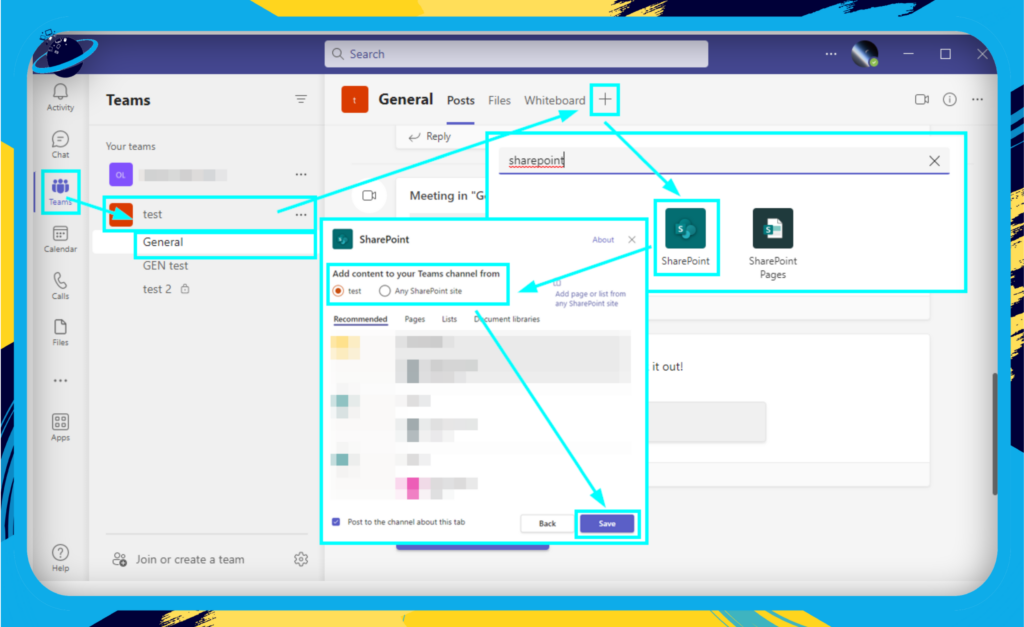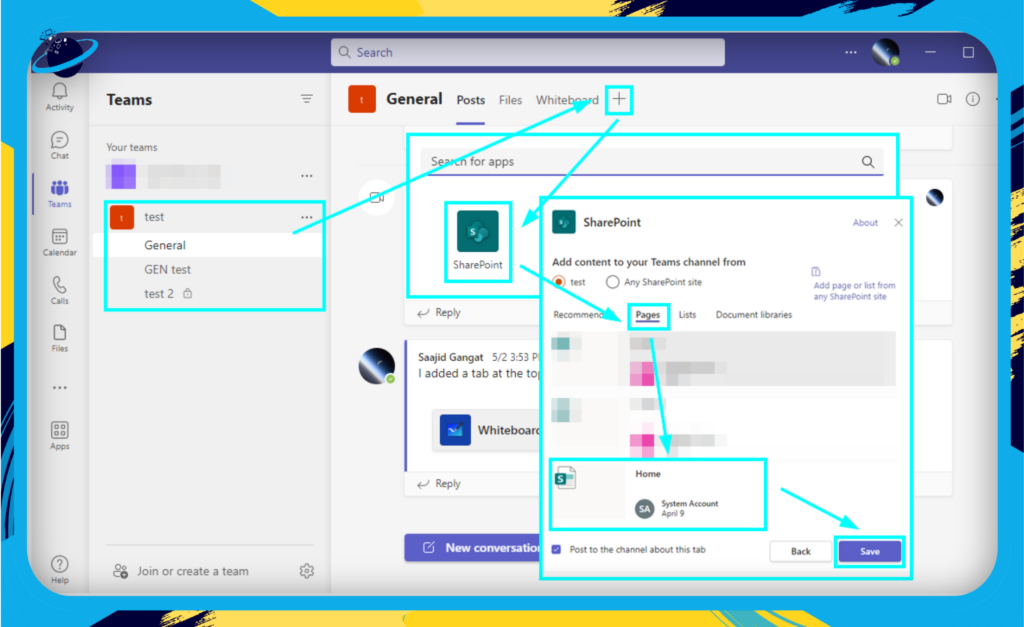Microsoft Teams and SharePoint are two essential tools for efficient communication and document management in the business world. By integrating the two, you can share documents, engage in discussions, and manage projects seamlessly. Our article will guide you through the process and show you the full potential of this powerful duo, improving efficiency and collaboration within your organization. Let’s get started!
 Table of content
Table of content


Getting to Know Microsoft Teams and SharePoint
In the current business landscape, understanding the tools at your disposal is half the battle won. So, before we plunge into the depths of their integration, let’s take a closer look at these two digital powerhouses: Microsoft Teams and SharePoint.
Microsoft Teams: The Hub of Teamwork
Microsoft Teams is a comprehensive communication and collaboration platform. Designed to streamline information flow and enhance productivity, it provides a wide array of features:

Unified Communication:
Combines chat, video meetings, and file sharing all in one place.

Collaboration:
Allows for real-time collaboration on files with Office apps like Word, Excel, PowerPoint, and OneNote.

Integration:
Seamlessly integrates with numerous external apps and tools.
Simply put, Microsoft Teams is like your virtual office space where communication and collaboration occur without the restrictions of physical boundaries.
SharePoint: The Powerhouse of Collaboration and Document Management
SharePoint, on the other hand, is a web-based collaborative platform that integrates with Microsoft Office. It is primarily a document management and storage system, but the product is highly configurable and its usage varies significantly among organizations. Here are its key features:
- Document Management: SharePoint allows you to store, share, and manage digital documents.
- Collaboration: Multiple users can collaborate on a document simultaneously.
- Customizability: Provides tools to build custom applications and components for your specific needs.
In essence, SharePoint is like your company’s digital library, where documents are stored, managed, and can be collaboratively worked on.
By this point, you might be wondering, “If both tools are so powerful independently, what magic could they weave together?” Stay tuned, as we unravel the mystery in the sections to come.
The Basics of Integration
When two powerful platforms like Microsoft Teams and SharePoint join forces, the possibilities are endless. However, before we delve deeper, let’s understand the basics of this union.
Integration at a Glance
Simply put, integration is all about making two separate systems work together harmoniously, and that’s exactly what we get when Teams and SharePoint are integrated. SharePoint acts as the backend document storage for Teams, and Teams surfaces SharePoint content front and center for easy collaboration.
Here are some key elements of this integration:

SharePoint and Teams Files:
Every Microsoft Teams team is connected to a SharePoint site, and every channel in Teams gets a corresponding folder in the SharePoint site. Any files shared within a Teams channel are automatically stored in SharePoint, ensuring easy accessibility and robust data management.

Tabs for Quick Access:
You can pin SharePoint pages, lists, or libraries as tabs within your Teams channel. This allows quick access to important information right from within Teams.
Why Integrate?
The integration of Microsoft Teams and SharePoint brings the best of both worlds together. It combines the flexibility and real-time collaboration of Teams with the powerful content management and sharing capabilities of SharePoint. Here’s why you might want to integrate:
- Improved Collaboration: With SharePoint files accessible directly in Teams, team members can seamlessly collaborate on documents in real time.
- Efficiency: Less time is wasted switching between apps, as most work can be done within Teams.
- Consistency: Data is consistently synchronized between Teams and SharePoint, ensuring everyone always has access to the most current version of files.
- Rich Experience: You can leverage SharePoint’s rich content experiences and capabilities, like Power Apps, right within Teams.
Don’t worry if this all seems a bit complex at first—the integration is designed to be transparent and smooth. So let’s get started on setting up the integration in the next section!
Setting up Microsoft Teams and SharePoint Integration
Now that we’ve set the stage, it’s time to roll up our sleeves and get our hands on the real stuff – integrating Microsoft Teams with SharePoint. Don’t worry, we’ll break it down into bite-sized steps that even the busiest of business users can follow with ease!
Prerequisites for Integration
Before we dive head-first into the integration process, let’s make sure we have everything we need:
- Microsoft Teams: Make sure you have a Microsoft Teams account and have the Teams app installed on your device.
- SharePoint Online: You need to have a SharePoint Online site. Remember, SharePoint is part of the Office 365 suite, so if you have an Office 365 subscription, you’re good to go!
Once these are in place, we’re ready to proceed.
Step-by-Step Integration Process
With our prerequisites checked off, let’s dive into the heart of the integration process.
- Open the Teams app.
- Click on “Teams.”
- Select a channel.
- Click on the “+” (Add a tab) button.
- Find and select “SharePoint.”
- Choose the content you want to integrate.
- Select a Team Site: If you choose this, Teams will suggest some SharePoint site pages or lists based on your activity. Select the one you want, and you’re all set!
- Enter the SharePoint Link: If you want to add a specific SharePoint page or list not suggested by Teams, select the Paste a link option. Paste the SharePoint link here and click “Save.”

You’ve done the work, now it’s time to see the results! A new tab should appear in your channel bearing the name of the SharePoint page or list you’ve added. Click it to view your SharePoint content right within Teams.
Congratulations, you’ve just successfully integrated Microsoft Teams with SharePoint!
Remember, this integration is not a one-size-fits-all solution, but a flexible tool. Feel free to explore and experiment to find out how it can best serve your unique business needs. Let’s harness the power of Microsoft Teams and SharePoint to drive collaboration and efficiency in your organization!
Features of Microsoft Teams and SharePoint Integration
The powerful duo of Microsoft Teams and SharePoint has several outstanding features that can supercharge your workflow. If you’ve wondered about the real perks of this integration, let’s break it down and get into the details.
File Sharing and Collaboration
One of the most useful features of integrating Teams with SharePoint is the seamless file sharing mechanism.
- When you share a file in a Teams chat or channel, it’s automatically stored in SharePoint, making it easy for everyone to find and collaborate on it.
- You can co-author documents with your teammates in real time, ensuring everyone is on the same page—literally!
Remember, all edits are saved in real time, so there’s no need to worry about losing any work!
Adding a SharePoint Page to a Teams Channel
A fantastic feature of the integration is the ability to add a SharePoint page or list to a Teams channel. This can serve as a “home page” for a project or a centralized location for important resources.
- Navigate to the channel where you want to add the page, select the ‘+’ (add a tab) button, choose SharePoint, and then select the page or list you want to add.
- This ensures that important SharePoint content is easily accessible right from within Teams.

Using SharePoint Framework (SPFx) for Teams
For businesses with specific needs, SharePoint Framework (SPFx) offers a method to create custom Teams apps.
- This means you can develop unique solutions tailored to your organization’s needs, improving efficiency and effectiveness.
- It might require a bit of tech savviness, but the customization possibilities are truly impressive.
These features form the backbone of the Teams and SharePoint integration, making it an invaluable resource for businesses looking for efficient and effective collaborative solutions. Next up, we’ll look at how these tools come together to improve collaboration across your organization!
Collaboration with Teams and SharePoint
In the world of business, it’s often said that teamwork makes the dream work. But without the right tools, collaboration can quickly turn into confusion. Here’s where the integration of Microsoft Teams and SharePoint truly shines, enabling you and your team to work together like never before. Let’s break down the key features.
Co-authoring Documents and Simultaneous Editing
- Microsoft Teams and SharePoint allow multiple users to work on the same document at once, a feature that truly transforms collaborative work. Forget about juggling multiple versions of a document – with real-time updates, everyone is always on the same page.
- To access this feature, simply upload a document to the Teams channel from your SharePoint site, and voila, you and your team can start working together instantly.
Integrated Communication
- Teams isn’t just about document collaboration; it’s also a hub for communication. The chat feature integrates seamlessly with SharePoint, keeping your discussions in context and in one place. This means that you can discuss a document right alongside the document itself, keeping conversations relevant and focused.
- Have team-wide discussions in dedicated channels.
- Conduct private chats or smaller group conversations.
- Even better, all your chat history stays right there, allowing anyone to catch up quickly on previous conversations.
Project Management
- One of the primary benefits of integrating Teams with SharePoint is how it makes managing projects a breeze. With SharePoint’s lists and Teams’ communication capabilities, you can easily track project progress, assign tasks, and keep everyone informed. Some of the functionalities include: Creating SharePoint lists for tasks, timelines, or other project management elements, and sharing them on your Teams channel.
- Discussing updates and resolving issues via Teams, directly alongside your SharePoint lists.
- Seamless collaboration on project files via SharePoint, right within your Teams workspace.
Remember, the goal is to leverage these tools to reduce redundancies, streamline processes, and foster effective collaboration. The key lies in understanding your team’s needs and tailoring these tools accordingly. And once you do, you’ll see why Teams and SharePoint are a match made in digital collaboration heaven!
Conclusion
In this enlightening journey, we have traversed the expansive landscape of Microsoft Teams and SharePoint integration. By now, you should have a clear understanding of the multitude of benefits this dynamic duo offers to modern businesses.
Let’s highlight some of the key points we’ve covered:
The Power of Integration
- SharePoint and Teams integration facilitates a seamless, intuitive, and efficient work environment.
- From file sharing to co-authoring documents and even hosting dynamic discussions, the integration opens a world of opportunities for enhanced collaboration.
Bolstering Business Productivity
- By bringing Teams and SharePoint together, businesses can streamline operations and boost productivity. This combination enables you to work on documents simultaneously with your colleagues, making collaboration smooth and easy.
Security and Compliance
- The security measures and compliance protocols in place help ensure your data stays safe and meets regulatory requirements. This added layer of protection lets you focus on what truly matters – driving your business to new heights.
The Future is Bright
- With continual advancements in digital collaboration tools, the future of Teams and SharePoint integration looks promising. We can look forward to more innovative features that will further enhance our ability to work together effectively.
Integrating Microsoft Teams and SharePoint transforms how you work and collaborate. Technology is a tool to solve problems, promote collaboration, and spur innovation. Embrace the future of work and create a more connected, productive environment. Let’s take bold steps together using integration. Keep innovating and collaborating until next time.
